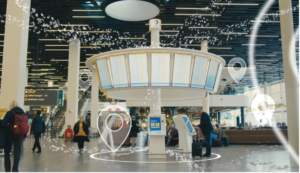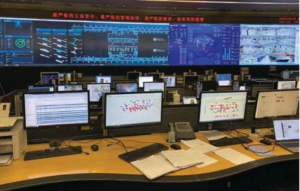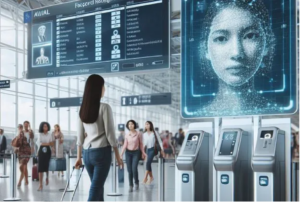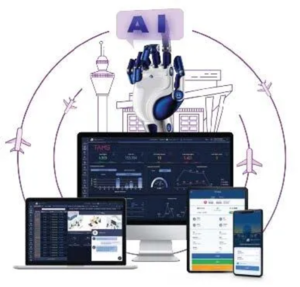Artificial intelligence is set to transform the passenger experience at airports. Passenger Terminal World explores some of the latest use cases for the technology.
According to Microsoft’s aviation UK chief technology officer, Daniel Williams, AI is really “changing the game” at airports around the world. The technology is set to have an impact on all areas of an airport, offering personalized customer experiences, efficient travel planning and booking and improved safety and sustainability, as well as many other benefits. “In terms of how it is used today, we have only just scratched the surface,” Williams says. “New use cases and applications for AI are emerging constantly and the technology is set to define the future of travel.”
In the September 2023 issue of Passenger Terminal World (see Smart watch, September 2023, p22*) experts explored how AI is being used for various operational processes within the airport, including identity checks, boarding, baggage and security screening and passenger flow. In addition to these use cases, Williams believes that AI’s potential to create “super-personalized passenger experiences” is yet to be fully explored.
“Ultimately, the entire airport and airline process is all about passenger experience,” he says. “Enhancing this is top of the to-do list for most operators as they seek to reduce the stress and anxiety experienced by passengers within the terminal before they travel. AI can play a big role in creating personalized passenger experiences that meet the specific needs of specific travelers.”
Williams believes this personalized passenger experience should cover the whole airport journey, right from booking a trip and traveling to the airport through to passing through the terminal and its retail and F&B offering and boarding the aircraft. And to achieve the ultimate passenger experience, all stakeholders involved in the passenger journey need to share their data, so that AI can be used to learn about specific travelers’ preferences and travel habits and then push information direct to those passengers’ devices.

“I believe this information should be provided via specific airport operator applications, which are seamless and use data from airlines, retailers and transportation organizations, as well as airport data, to provide incentives to dine in specific F&B outlets, or discounts for shopping in stores,” Williams explains. “These discounts or incentives are based on the passenger’s previous travel choices. Business travelers have different travel habits from those of a family traveling through an airport, so it’s important to use tools like AI to learn what these habits are and then provide promotions direct to the passenger to improve their travel experience, while in turn increasing spending at the airport.”
Microsoft works closely with Schiphol in Amsterdam, which according to Williams has sensors throughout the terminal collecting data on passenger movement and behavior. It uses this data to inform the layout and design of the hub, including addressing bottlenecks to improve passenger flow. “Schiphol is extremely focused on innovation, and it creates spin-off products and solutions that benefit the rest of the aviation industry,” he adds.
Schiphol’s Passenger Experience Platform
One of those solutions is the Schiphol Passenger Experience Platform, which has been developed as a “Swiss Army Knife for passenger experience”, according to Tijn Borms, the product owner of the platform. “It basically helps airports provide their passengers with a stress-free journey by answering any questions they have and helping them to enjoy their time spent in the terminal. It also helps airports discover operational and commercial opportunities,” he says.
The Passenger Experience Platform began life back in 2017 when Schiphol was looking for a way to replace its manned information kiosks, which were costly to run and took up a lot of space in the terminal. Schiphol decided to replace these kiosks with self-service units (SSUs) that focused on answering passenger questions. “Around 90% of these questions were answered in a fully automated way, offering flight information, terminal wayfinding and other Q&As,” says Borms. “Passengers can also connect with agents through the SSU via video call if needed.”
This solution is now also available on mobile devices, using the same platform developed for the SSUs. “We’re now also adding new specialized hardware modules, such as a call point for passengers with reduced mobility and other passengers facing physical and/or mental disabilities,” explains Borms.
The platform brings together data and insights from conversations between agents and passengers and, according to Borms, “years of anonymous behavioral passenger data, such as where they have come from, where they are going, what features they are using”, and so on. “This is then processed to become relevant for the passenger and/or the airport. It is also used to train AI models.”

The use of AI to improve the Passenger Experience Platform is still in the early stages, but Borms is confident that the technology can play a big role in enhancing the solution. “At Schiphol we have been leveraging AI for quite a while already, but this has always been for operational processes, such as Deep Turnaround, which improves aircraft turnaround processes based on historic, real-time and predictive insights for all stakeholders. Based on our experiences, we now know pretty well what the technology is capable of, and we have a team of AI/ML experts who can’t wait to get their hands dirty to boost passenger experience too,” he says.
Borms and his team will first look at how AI can be used to get better answers for passengers, faster, using the likes of ChatGPT. The platform will also be used to send out flight notifications to passengers via WhatsApp. “We are also exploring how passengers can respond to those messages and interact with the platform via a conversation user interface,” explains Borms.
Using AI, the platform will not only indirectly contribute to non-aeronautical revenues (a 1% increase in passenger satisfaction generates an average 1.5% growth in non-aeronautical revenue, according to ACI’s Airport Service Quality Survey2021), but also increase revenues in a more direct way. “We know the personal itinerary of the passenger and based on that can come up with relevant propositions for them,” says Borms.
“AI will help more passengers to help themselves,” he continues. “It’ll make our agents more effective, and it will help us better understand the needs of our passengers so we can produce personalized offers that boost their passenger experience even more and will make us some revenues in the meantime.”
The Passenger Experience Platform is currently in use at Schiphol and Hamad airports, with the team in talks with many other airports for rollout as well. “We want to build the best and most versatile passenger experience platform for airports in the market,” he says. “Additionally, we want to contribute to the passenger experience of as many airports as possible.”
Generative AI
Many of the latest features of the Passenger Experience Platform, such as its ability to generate flight notifications and a future capability to automatically generate Q&A articles based on previous operator-passenger conversations, have been enabled by the development of generative AI, which focuses on creating new and original content from vast data sources.

“Up until last year, it was largely the academic and research communities that were concerned with AI development, with some experimentation in industry,” says Dr Kitty Hung, principal consultant at AtkinsRéalis. “However, that all changed in November 2022 when generative AI apps such as ChatGPT by OpenAI, Bing Chat by Microsoft, DALL-E, Midjourney and Stable Diffusion launched in the consumer market. The first half of 2023 also saw the launch of two other generative AI tools called Bard by Google and Claude by Anthropic.
“The technological advancement of GenAI is a big leap forward from its predecessor, AI. While AI doesn’t generate textual content such as documentation and computer code, or multimedia content such as images, voice and video, GenAI, through the large language model (LLM), does,” Hung adds.
In the airport environment, GenAI offers huge potential, according to Hung. “It can, for example, automate a variety of administrative and operational tasks, freeing up employees’ time to tackle more complex programs.”
Hung highlights London Heathrow’s use of GenAI technology, which has been rolled out in cooperation with Capgemini and is aimed at boosting passenger experience through the AI for Customer Experience solution. The offering includes four dedicated AI assistants designed for a ‘hyper-personalized’ experience: a synthetic design assistant, personalized chatbots, a content and knowledge assistant for customer care services, and a product and offers knowledge assistant.

TAV Technologies is also exploring how GenAI can enhance its airport operations solution, the Total Airport Management Suite. TAMS serves as a central platform for overseeing all airport processes, covering landside and airside operations. It integrates existing systems, providing a unified and holistic architecture for comprehensive airport management. It offers multiple solutions such as flight management, airport resource management, capacity planning, commercial management and ground handling services.
“TAMS leverages AI’s predictive analytics to offer predictive decision making such as flight delays, enabling airports to make informed resource planning decisions and reducing disruptions for passengers,” explains M. Kerem Ozturk, general manager at TAV Technologies. “Furthermore, the automation capabilities within TAMS significantly minimize human error and workload, streamlining operational tasks and contributing to smoother airport experiences.
“TAV Technologies is also expanding TAMS with GenAI capabilities, allowing users to seek information through natural language queries (NLP), simplifying reporting and decision making processes for airport staff and ultimately benefiting passengers.”
Ozturk warns that the application of AI, especially GenAI, introduces new dimensions of risk in the airport environment. “These risks encompass privacy violations, discrimination and the credibility of AI responses,” he says.
SITA, which is well known in the airport sector for its AI-based data analytics solutions, such as the WorldTracer Lost and Found Property solution and its Smart Path biometric checkpoint technology, is also aware of the new risks associated with GenAI. “The most known is when ChatGPT ‘hallucinates’ and provides answers that sound convincing but are wrong or just invented,” explains Gustavo Pina, director of the SITA Lab.
“In the case of LLMs, careful use of prompt engineering and limiting the LLM to a specific data source, such as an airport’s operations manual, can prevent this happening. Until trust in these systems is established, it is important to have a human in the decision making process and to build guardrails to autonomous systems,” Pina adds.
The SITA Lab is currently working on a next-generation digital assistant that leverages LLMs to create much richer chatbot-type interfaces than the first-generation chatbots, Pina notes. “These bots have access to a combination of airport manuals, passenger points of interest and real-time operational data. These assistants can be deployed at the airport to augment existing information service desks or within airline and airport apps.”
New use cases for AI
Microsoft’s Williams also highlights how generative AI chatbots are being enhanced thanks to better AI tech, enabling information such as flight times, retail offers, multilingual support and immigration to be available on demand on passengers’ devices.
“Another interesting use case for AI, which is just emerging, is fraud detection. Airports are exploring the use of AI to detect passengers ‘double-dipping’ with complaints,” he explains. “This basically means when the passenger makes a complaint about a service or facility, such as a badly maintained toilet, they call the airport operator to complain, complain separately on X [previously Twitter] and again via email. These are three separate complaint threads and, in some cases, this leads to three lots of compensation, when it should just be one. AI can be used to capture data from these different threads and to detect anomalies to prevent fraud.”
Williams also believes the airport sector will see increased use of AI for waste management, energy management and predictive maintenance. “AI could help predict when to turn on the lighting or air-conditioning, for example, based on data about passenger flow, weather conditions and flights. This could drastically reduce emissions and costs,” he adds.
Microsoft works with several airports around the world, including Fraport’s airports in Germany, London Heathrow, Schiphol and Melbourne, using its Microsoft Azure AI-based platform to improve operations. According to Williams, one of the company’s most notable recent projects was at Heathrow, where it worked with Smiths Detection as part of Project SEEKER to train models to detect illegal wildlife items in luggage and cargo. Microsoft trialled the Azure-based technology to scan up to 250,000 bags a day at Heathrow, and recorded a more than 70% successful detection rate for illegal wildlife items.
AI rollout advice
For any new use cases for AI, Williams recommends that airports start with a clear vision for what they want to achieve. “You also need to ensure that your data collection and data management are high quality. Bad data leads to bad output,” he says. “Airports should also partner with good vendors and large global system integrators that are well known in the AI space as they will understand the market.
“It’s also important to start small with projects that have good impact but require low effort. Use the success of the first project to create a snowballing effect to move forward. And finally, get buy-in from absolutely everyone – not just within the business, but from your passengers as well,” he concludes.
TAV Technologies’ Ozturk agrees that a well-defined strategy and clear objectives, along with data quality and passenger buy-in, are essential to any AI-based project. “Furthermore, while AI offers numerous benefits to airport operations, embracing a human-in-the-loop approach is essential,” he continues. “AI should function as an aid to human decision making rather than a complete replacement. Establishing a human oversight mechanism to maintain accountability and intervene when necessary is of utmost importance.”
PASSENGER TERMINAL CONFERENCE
Microsoft’s Daniel Williams will discuss the latest airport AI trends and use cases at this year’s conference!
This article originally appeared in the January 2023 issue of Passenger Terminal World. To view the magazine in full, click here.


